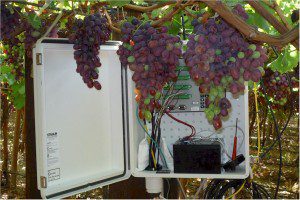
A logger is used to record the evapotranspiration of the vines in the GrapeLook project. GrapeLook uses satellite remote sensing to monitor how much water is released from the plants, how much biomass is grown and how efficiently the water is being used overall.
GrapeLook, a European Space Agency (ESA) service, uses satellites to help decide how much to water vineyards and when. The service uses technology that combines Earth observation data and field measurements. Moisture readings are sent in real time to a processing centre via a satellite link.
To use the water most efficiently, growers need information on crop production and water consumption. GrapeLook uses satellite remote sensing to monitor how much water is released from the plants, how much biomass is grown and how efficiently the water is being used overall. Once the information is processed, the maps are put online for the grape growers and water managers through a Google Maps-based Web site.
GrapeLook was tested this year with selected grape growers in South Africa. The growers connected regularly to the website to check the status of their vineyards. The group also received forecasts on soil moisture and irrigation requirements for their farms.
Participants agreed that GrapeLook was useful for monitoring water stress, crop growth and identifying irrigation problems. It helped to identify more efficient practices and would help in reducing labour and other costs. The system should increase the amount of grapes being harvested while raising the quality of the wine”all the while using less water.
The trial period of this project showed that the farmers and water authorities were supportive of such a service, explains Olivier Becu,ESAtechnical officer. While it may take a few years to strengthen trust and awareness with these user communities, the South African authorities are willing to support a freely available GrapeLook service for another season.
Annemarie Klaasse, land and water use specialist at WaterWatch, explains: The GrapeLook service shows how satellite technology benefits farmers. It not only helps farmers to reduce water usage, it also increases sustainability and production. Next steps are to expand the service to other crops and areas.
The service was developed by WaterWatch (NL), supported byESA's Integrated Applications Programme and co-funded by the Department of Agriculture of Western Cape in South Africa, in collaboration with the University of KwaZulu-Natal and with support of the Department of Agriculture, Fisheries and Forestry and the Dutch Embassy.
Source: European Space Agency

